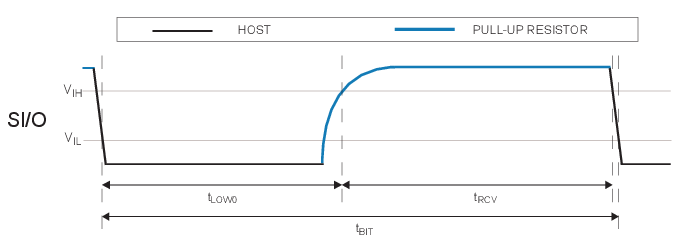4.3.2.4 Data Input Bit Frame
A data input bit frame can be used by the host to transmit either a logic ‘0’ or a logic ‘1’ data bit to the ECC204-TFLXAUTH. The input bit frame is initiated when the host drives the SI/O line low. The length of time that the SI/O line is held low will dictate whether the host is transmitting a logic ‘0’ or a logic ‘1’ for that bit frame. For a logic ‘0’ input, the length of time that the SI/O line must be held low is defined as tLOW0. Similarly, for a logic ‘1’ input, the length of time that the SI/O line must be held low is defined as tLOW1.
The ECC204-TFLXAUTH will sample the state of the SI/O line
after the maximum tLOW1 but prior to the minimum tLOW0 after SI/O is driven below the VIL threshold to determine if the data input is a logic ‘0’
or a logic ‘1’. If the host is still driving the line low at the sample
time, the ECC204-TFLXAUTH will decode that bit frame as a logic
‘0’ as SI/O will be at a voltage less than VIL. If the host has already released the SI/O line, the ECC204-TFLXAUTH sees a voltage level greater than or equal to
VIH because of the external pull-up resistor, and that
bit frame is decoded as a logic ‘1’.
A logic ‘0’ condition has multiple uses similar to I2C sequences. It is used to signify a ‘0’
data bit and it is also used for an ACK response. Additionally, a logic
‘1’ condition is used for a NACK response in addition to the
nominal ‘1’ data bit.
The figures below depict the logic ‘0’ and logic ‘1’ input bit frames.
0’ Input Condition Waveform
1’ Input Condition Waveform
